|
|
|
Sort Order |
|
|
|
Items / Page
|
|
|
|
|
|
|
| Srl | Item |
| 1 |
ID:
122943
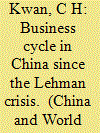

|
|
|
|
|
| Publication |
2013.
|
| Summary/Abstract |
The major objectives of China's macroeconomic policy are to stabilize economic growth and inflation, which, in turn, are important factors determining key prices, such as the policy interest rate, the renminbi exchange rate and stock prices. In a framework that distinguishes different phases of the business cycle based on whether the current period's economic growth rate and inflation rate are above or below their "normal" values, this paper analyzes the interaction among macroeconomic policy, economic growth and inflation in China since the Lehman crisis, and the implications for these key prices. The path of China's economy indicates that stimulus measures taken by the government during the recession phase and tightening measures implemented during the overheating phase have helped minimize the fluctuation over the business cycle. Our analysis shows that Chinese authorities tend to rely more on adjusting the exchange rate than the interest rate to stabilize the economy. Comparing with conditions at the time of the post-Lehman recession, the current slow pace of economic growth in China may reflect not only weakening demand, but also a lower potential growth rate associated with the arrival of the Lewis turning point.
|
|
|
|
|
|
|
|
|
|
|
|
|
|
|
|
| 2 |
ID:
086700
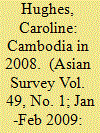

|
|
|
|
|
| Publication |
2009.
|
| Summary/Abstract |
The Cambodian People's Party (CPP) consolidated legislative control with a decisive election victory in 2008. Four contributing factors are identified: CPP control of local authorities who can deliver the vote, its marginalization of the opposition, the mass patronage enabled by an economic boom, and exploitation of a border dispute with Thailand.
|
|
|
|
|
|
|
|
|
|
|
|
|
|
|
|
| 3 |
ID:
105071
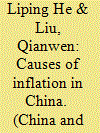

|
|
|
|
|
| Publication |
2011.
|
| Summary/Abstract |
This paper argues that the main causes of inflation in China since the early 21st century are changes in the public's inflation expectations. The conventional wisdom, the quantity theory of money, may not be adequate to capture the relationship between price changes and money supply growth, as the economic system evolves and people's income and wealth grow. An examination of China's GDP deflator and broad money supply relative to nominal GDP shows that the relationship between the two series is relatively weak. A further examination of China's monthly CPI series over the period 2001-2010 reveals that the autoregressive models are a better fit than the moving average models, which suggests that the role of CPI expectations has been significant and important. Because of the importance of inflation expectations in CPI movement, we believe the Central Bank's monetary policy that targets CPI inflation should emphasize the use of policy instruments that have direct and strong communication links with the public. Quantitative measures would have their own use, but their effectiveness would be unlikely to match that of interest rate measures, especially from a short-term perspective.
|
|
|
|
|
|
|
|
|
|
|
|
|
|
|
|
| 4 |
ID:
186863


|
|
|
|
|
| Summary/Abstract |
The ability to finance conflict likely affects the odds of sustaining a war and succeeding in it. Recent literature explores rebel group funding, but far less is known about how states finance their own war efforts. This article posits that the design of central banks should affect civil war termination. In particular, it argues that central bank independence affects civil war termination through two channels. First, financial markets consider central bank independence as a good signal in terms of macroeconomic stability and debt repayment. In this way, independent central banks enhance the ability of the government to access credit to finance and end a civil war. Second, central bank independence is associated with lower inflation. Inflation control reduces one source of additional grievances that the civil war may impose on citizens. On a sample of civil wars between 1975 and 2009, central bank independence is associated with a substantial increase in the likelihood of war termination. When the form of termination is disaggregated, (higher) central bank independence is associated with a higher probability of government victory, relative to continued conflict and to other outcomes. Additional tests provide support for the argued mechanisms: during civil wars, countries with more independent central banks access international credit markets in better conditions – i.e. they pay lower interest rates, and receive longer grace and maturity periods on new debt. Furthermore, in countries experiencing civil wars, central bank independence is associated with lower inflation.
|
|
|
|
|
|
|
|
|
|
|
|
|
|
|
|
| 5 |
ID:
131397
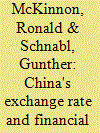

|
|
|
|
|
| Publication |
2014.
|
| Summary/Abstract |
Instability in the world dollar standard, as most recently manifested in the US Federal Reserve's near-zero interest rate policy, has caused consternation in emerging markets with naturally higher interest rates. China has been provoked into speeding RMB "internationalization"; that is, opening up domestic financial markets to reduce its dependence on the US dollar for invoicing trade and making international payments. However, despite rapid percentage growth in offshore financial markets in RMB, the Chinese authorities are essentially trapped into maintaining exchange controls (reinforced by financial repression in domestic interest rates) to avoid an avalanche of foreign capital inflows that would threaten inflation and asset price bubbles by driving nominal interest rates on RMB assets down further. Because a floating (appreciating) exchange rate could attract even more hot money inflows, the People's Bank of China should focus on keeping the yuan/dollar rate stable so as to encourage naturally high wage increases to help balance China's international competitiveness. However, further internationalization of the RMB, as with the proposed Shanghai pilot free trade zone, is best deferred until world interest rates rise to more normal levels.
|
|
|
|
|
|
|
|
|
|
|
|
|
|
|
|
| 6 |
ID:
113329
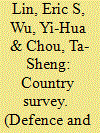

|
|
|
|
|
| Publication |
2012.
|
| Summary/Abstract |
In this article we survey military spending, the evolution of national defense policy, and the role that defense spending played in economic activities in Taiwan from 1952 to 2009. With the ongoing cross-Strait dialogue and closer commercial ties between Taiwan and China, the share of military spending in government expenditures (or GDP) has tended to gradually decline, which is in accordance with the change in defense policy from an offensive posture to a defensive-oriented attitude. In addition, we investigate the defense spending-inflation nexus in Taiwan. The multivariate structural change test identifies two break points and three regimes are categorized accordingly. The Granger causality test based on the VAR model reveals that the heavy defense burden in Taiwan during 1952-71 (the first regime) is essentially an important factor causing the higher price levels. However, when the tension across the Taiwan Strait is alleviated as well as the defense-oriented policy adopted, the military spending no longer plays a crucial role in determining inflation in the recent two regimes. Sensitivity analysis confirms that our results are robust to different model specifications.
|
|
|
|
|
|
|
|
|
|
|
|
|
|
|
|
| 7 |
ID:
126546
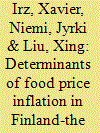

|
|
|
|
|
| Publication |
2013.
|
| Summary/Abstract |
The agricultural commodity crisis of 2006-2008 and the recent evolution of commodity markets have reignited anxieties in Finland over fast-rising food prices and food security. Little is known about the strength of the linkages between food markets and input markets, such as the energy market. Using monthly series of price indices from 1995 to 2010, we estimate a vector error-correction (VEC) model in a cointegration framework in order to investigate the short-term and long-term dynamics of food price formation. The results indicate that a statistically significant long-run equilibrium relationship exists between the prices of food and those of the main variable inputs consumed by the food chain, namely agricultural commodities, labour, and energy. When judged by the magnitude of long-run pass-through rates, farm prices represent the main determinant of food prices, followed by wages in food retail and the price of energy. The parsimonious VEC model suggests that the dynamics of food price formation are dominated by a relatively quick process of adjustment to the long-run equilibrium, the half life of the transitional dynamics being six to eight months following a shock.
|
|
|
|
|
|
|
|
|
|
|
|
|
|
|
|
| 8 |
ID:
109743
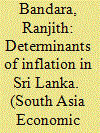

|
|
|
|
|
| Publication |
2011.
|
| Summary/Abstract |
A high and sustained economic growth in conjunction with low inflation is the central objective of macroeconomic policy formulation in both developed and developing countries. Further, studying inflationary processes is an important issue in the current scenario as it allows policy-makers to achieve monetary and economic targets. However, it is not an easy task, especially in developing coun-tries, where economic processes are highly unstable and volatile. The situation in Sri Lanka is not exceptional. Therefore, understanding the behaviour of inflation is vital for the policy-makers in macroeconomic management as Sri Lanka is currently moving into new era of economic development. This article investigates the determinants of inflation in Sri Lanka during 1993-2008, a period which was characterized by upward and downward trends in the economy. Vector auto-regressive (VAR) models were used to find out appropriate explanations for inflation with accompanied application of Granger Causality Tests. The overall findings of estimated VAR models imply that the money supply, exchange rate and the GDP have information which helps in exploring the behaviour of the inflation in Sri Lanka.
|
|
|
|
|
|
|
|
|
|
|
|
|
|
|
|
| 9 |
ID:
111145
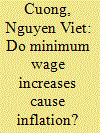

|
|
|
| 10 |
ID:
151404


|
|
|
|
|
| Summary/Abstract |
This study provides evidence from Pakistan on how the delegated task of achieving strategic objectives of the donor can lead to incompatibility of aid objectives which then generates perpetual and multidimensional domestic conflict in the recipient society. We use count data method to estimate the relationship between aid and conflict. At the aggregate level, social sector spending, regime change and youth bulge are positively and significantly related with conflict. However, aid per capita gives ambiguous results. It is significant with conflict count in the terrorism data-set and insignificant for data on armed conflict. Inclusion of youth bulge and unemployment rate confirms the marginalization hypothesis of conflict. Inflation rate and the tax variables are insignificant. This confirms that aid erodes fiscal capacity. At project-level data, conflict is strongly related with aid commitment and purpose. Discrepancy in aid allocation and commitment may accentuate conflict.
|
|
|
|
|
|
|
|
|
|
|
|
|
|
|
|
| 11 |
ID:
086910


|
|
|
|
|
| Publication |
New York, Monthly Review Press, 1972.
|
| Description |
237p.
|
|
|
|
|
|
|
|
|
|
|
|
Copies: C:1/I:0,R:0,Q:0
Circulation
| Accession# | Call# | Current Location | Status | Policy | Location |
| 011467 | 330.12209/SWE 011467 | Main | On Shelf | General | |
|
|
|
|
| 12 |
ID:
138901
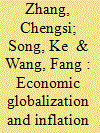

|
|
|
|
|
| Summary/Abstract |
This paper evaluates whether globalization has increased the role of global factors in driving inflation in China. Unlike other published studies on the relationship between globalization and inflation, which mostly use Phillips curve models, this paper uses multivariate dynamic models to examine the dynamic interactions between globalization and inflation in China. Empirical results with quarterly data spanning from 1995 to 2012 show that the global output gap significantly affects the dynamics of inflation in China. In particular, the global output gap is superior to the domestic output gap in predicting domestic inflation. Impulse response and variance decomposition analyses reinforce this finding. Our results indicate that the central bank of China should take developments in global output into account in its monetary policy-making process.
|
|
|
|
|
|
|
|
|
|
|
|
|
|
|
|
| 13 |
ID:
129476
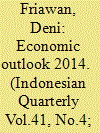

|
|
|
|
|
| Publication |
2013.
|
| Summary/Abstract |
Looking ahead, the outlook in 2014 is expected to see sizeable downside risks, coming from both domestic and external sides. It is estimated that the economic growth in 2014 would remain under 6.0 percent as the country's economy is much more impacted by tighter economic condition, lower commodity prices, as well as uncertainty in financial market and regulatory regime in the run-up to the 2014 election, offsetting the positive effects of global economic recovery and rising spending related national election. Inflation rate, meanwhile, is projected to ease and return to the Bank Indonesia's target band of 4.5:] percent in 2014, as the effect of the effect of the fuel price increases may have subsided and the aggregate demand growth slows.
I however, the recent depreciation in rupiah, the minimum wage hikes for next year, and the second and third-round effects from the increase in fuel prices and electricity billing rates may give further in?ationary pressures to the outlook. As for external side, a modest narrowing in current account deficits is expected to be help by slowing imports, as investment growth continues moderate in 2014.
|
|
|
|
|
|
|
|
|
|
|
|
|
|
|
|
| 14 |
ID:
086606
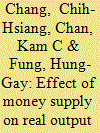

|
|
|
|
|
| Publication |
2009.
|
| Summary/Abstract |
Over the past 30 years, China has achieved remarkable long-term economic growth. Using quarterly data, we study the effects of money supply on real output and inflation in China between 1993 and 2008. To this end, we use money supply shocks after filtering out the expected component of the money supply. Our findings provide evidence supporting the asymmetric effect of positive and negative money supply shocks on real output and inflation in China. That is, real GDP growth in China responds to negative money supply shocks but not positive money supply shocks. In addition, inflation responds to positive money supply shocks but not negative money supply shocks. We conclude that the People's Bank of China's policy of steady monetary growth appears to be appropriate. Our study offers important policy implications for China.
|
|
|
|
|
|
|
|
|
|
|
|
|
|
|
|
| 15 |
ID:
162650
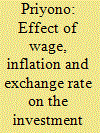

|
|
|
|
|
| Summary/Abstract |
The purpose of this study is to know and analyze the effect of wage variables on regional investment policy, the influence of inflation variables on regional investment policy, and the influence of exchange rate variables on investment policy of the Region on Labor. In this study, the population taken is the entire workforce whose data comes from the Central Bureau of Statistics in Sidoarjo which amounted to 64,792 workers. Data analysis using multiple linear regressions with the help of SPSS program version 20 showed that there is an influence of wages, inflation, and exchange rate on local investment policy. Based on the results of calculations and test results conducted, it can be explained that there is an effect of wages on regional investment of labor followed by the characteristics of inflation on labor that affects the exchange rate of investment. This illustrates for policymakers which empirical evidence exists in a series of time to test the theoretical basis while establishing fiscal, monetary, or exchange rate policies to stabilize output and employment by using interest rates, money supply, and exchange rates as instruments for achieving goals.
|
|
|
|
|
|
|
|
|
|
|
|
|
|
|
|
| 16 |
ID:
188446
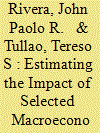

|
|
|
|
|
| Summary/Abstract |
As economic activities came to a standstill during the COVID-19 pandemic, the Philippines, like many economies across the globe, experienced rising inflation, currency depreciation and fluctuating capital markets. To manage these variables and stabilize the macroeconomy, the central bank resorted to monetary tightening. In the Philippines, a key mechanism that contributes to this stabilizing effect rests on remittances that have been cushioning the economy from the effects of volatilities and uncertainties in the global economy. During economic downturns and reduced capital flows, remittances provide support not only to recipient households but also to the country’s financial sector. Using time series analysis, we estimate the response of remittance inflows on impulses from selected macroeconomic variables, namely interest rate, inflation rate and exchange rate. A common characteristic shared by the selected indicators is their influence on recipient households’ consumption-related decision-making process. These findings warrant the need to redesign major institutional policies to manage remittances in light of their anticipated feedback effect on the economy.
|
|
|
|
|
|
|
|
|
|
|
|
|
|
|
|
| 17 |
ID:
108390
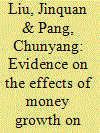

|
|
|
|
|
| Publication |
2011.
|
| Summary/Abstract |
Since the latter half of 2010, a new round of inflation has gradually been manifesting in China. The debate regarding whether excess money supply is responsible for this inflation has attracted scholars to investigate the effects of money growth on inflation. In this paper, we use correlation analysis to confirm the comovement between growth of monetary aggregates and inflation. We explore the asymmetric effects of monetary policy on inflation using the Markov regime-switching model. The empirical results show that monetary policy can be more effective in curbing inflation in a high inflation state than in boosting the price level in a low inflation state. However, simply tightening the money supply might not be sufficient to suppress the price level. To this end, the Chinese Government should adopt other policies, such as supply stabilization policies, to help suppress the price level. Our study can help policy-makers to determine the actual economic state and provides some policy implications for the current inflation.
|
|
|
|
|
|
|
|
|
|
|
|
|
|
|
|
| 18 |
ID:
155101


|
|
|
|
|
| Summary/Abstract |
Though an accumulating body of work has analysed monetary policy transmission in India, there are few studies examining the asymmetric aspect of the transmission. Against this backdrop, segregating the interest rate setting process captured by a Taylor rule type into unanticipated and anticipated components, this article analyses the asymmetric effects of monetary policy on aggregate demand and its components, and inflation in India using quarterly data from 1996–97Q1 to 2013–14Q3. It finds that unanticipated hikes and cuts in the policy rate have a symmetric impact on aggregate demand, but differentially impact the components. While the impacts on investment are negative and symmetric, they are asymmetric on private consumption, with only an unanticipated cut in policy rate having a significant negative impact. Government consumption is unaffected by monetary policy shocks. The impact of unanticipated interest rate changes on inflation is negative and symmetric. Anticipated policy rate changes also have a negative impact on aggregate demand and its components, except for government consumption, but between certain levels, such changes are ineffective, indicating a neutral impact. Anticipated policy rate changes have a negative impact on inflation at all levels.
|
|
|
|
|
|
|
|
|
|
|
|
|
|
|
|
| 19 |
ID:
082639
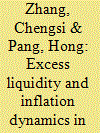

|
|
|
| 20 |
ID:
086474
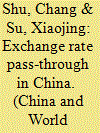

|
|
|
|
|
| Publication |
2009.
|
| Summary/Abstract |
During the second half of 2007 and early part of 2008 when there were intense inflationary pressures in China, RMB appreciation was advocated as a means of helping to curb inflation. The effectiveness of appreciation in controlling inflation depends on the impact of exchange rate movements on import and domestic prices. Our analysis finds fairly large and speedy exchange rate pass-through (ERPT) to import prices: 50 and 60 percent for the short run and long run, respectively. However, the degree of ERPT decreases along the price chain from upstream to downstream prices. ERPT for consumer prices, the most downstream prices, is much milder and has substantial lags. A 10-percent rise in the nominal effective exchange rate will dampen consumer prices by 1.1 percent within a year, with very little pass-through in the first half year, and by 2.0 percent over the long run. These findings, particularly the ERPT to consumer prices, suggest that RMB appreciation can help to reduce inflationary pressures over the longer term. However, it is unlikely to provide rapid relief to the current round of high inflation because of the long lags in ERPT. The RMB needs to strengthen in effective terms to exert the desired dampening impact on prices.
|
|
|
|
|
|
|
|
|
|
|
|
|
|
|
|
|
|
|
|
|